The nano zinc oxide market is estimated to be valued at USD 433.8 million in 2025 and is projected to reach USD 1231.8 million by 2035, registering a compound annual growth rate (CAGR) of 11.0% over the forecast period.
The global nano zinc oxide market is set for substantial growth, projected to reach USD 1.23 billion by 2035, growing at a CAGR of 11% from 2025 to 2035. From an initial value of USD 433.8 million in 2025, the market will see an increase in demand driven by rising application in industries such as personal care, electronics, and energy-efficient technologies. As demand for high-performance materials continues to grow, nano zinc oxide’s role in enhancing product formulations, especially in sunscreens, anti-bacterial coatings, and semiconductors, will be crucial in driving market expansion.
Increasing industrial and consumer application trends are expected to foster growth across multiple sectors. The rising interest in products featuring nano zinc oxide, driven by its superior properties like UV protection and antimicrobial benefits, has strengthened its presence in the personal care industry. With applications extending into energy-efficient devices, the growth of the electronics and automotive industries is also anticipated to contribute significantly to market growth. These shifts reflect a larger trend of rising industrial demand for advanced materials, and nano zinc oxide’s application in various coatings and additives continues to expand, positioning it for long-term market traction.
Cosmetics and personal care applications represent a substantial market segment where nano zinc oxide functions as ultraviolet radiation protection in sunscreens, antimicrobial agent in skin care formulations, and opacifying component in color cosmetics. Formulators balance UV protection effectiveness against aesthetic considerations including transparency, spreadability, and absence of white residue that conventional zinc oxide creates.
Regulatory frameworks across different jurisdictions establish particle size limitations, safety testing requirements, and labeling obligations that affect product development and market access. Manufacturing processes must ensure consistent particle size distribution, surface treatment compatibility, and microbiological purity that meet cosmetic grade specifications.
Electronics manufacturing utilizes nano zinc oxide in transparent conductive films, varistor applications, and semiconductor devices where electrical properties depend on precise control of particle morphology and crystal defects. Production facilities require clean room environments, specialized characterization equipment, and quality control systems that monitor electrical conductivity, optical transparency, and thermal stability properties.
Supply chain relationships involve electronics manufacturers who specify exact particle size ranges, surface area requirements, and electrical performance characteristics that determine component functionality and manufacturing yield rates.
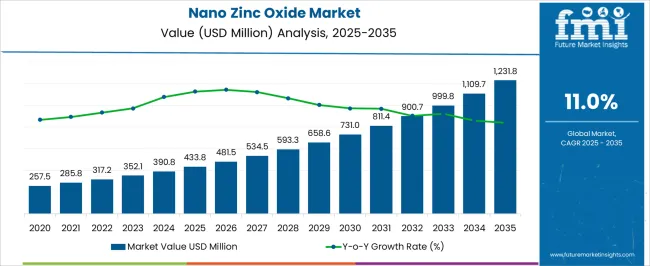
| Metric | Value |
|---|---|
| Nano Zinc Oxide Market Estimated Value in (2025 E) | USD 433.8 million |
| Nano Zinc Oxide Market Forecast Value in (2035 F) | USD 1231.8 million |
| Forecast CAGR (2025 to 2035) | 11.0% |
The nano zinc oxide market is experiencing steady growth, driven by its multifunctional properties and expanding applications across consumer and industrial sectors. Demand is being supported by its use in personal care products, coatings, electronics, and packaging, where UV protection, antimicrobial activity, and transparency are valued. Increasing regulatory approvals for safe usage in cosmetics and food contact materials have enhanced market acceptance.
Advancements in nanotechnology are enabling controlled particle size distribution and surface modifications, which improve dispersion, stability, and performance in end-use products. Rising consumer awareness about sun protection and the harmful effects of UV radiation is contributing to its growing role in skincare formulations. In industrial sectors, its incorporation into coatings and plastics is improving product durability and resistance to environmental degradation.
Manufacturers are focusing on sustainable production processes and compliance with global safety standards to meet evolving consumer and regulatory requirements As industries prioritize high-performance materials with multifunctional capabilities, nano zinc oxide is expected to remain a critical component in future product innovations and market growth.
The nano zinc oxide market is segmented by product type, application, and geographic regions. By product type, nano zinc oxide market is divided into Coated nano ZnO and Un-coated Nano ZnO. In terms of application, nano zinc oxide market is classified into Personal Care & Cosmetics, Paints & Coatings, Textiles, Electronics, and Other applications. Regionally, the nano zinc oxide industry is classified into North America, Latin America, Western Europe, Eastern Europe, Balkan & Baltic Countries, Russia & Belarus, Central Asia, East Asia, South Asia & Pacific, and the Middle East & Africa.
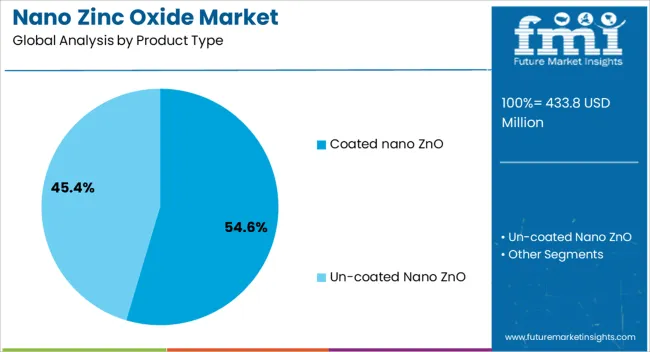
The coated nano zinc oxide segment is projected to hold 54.6% of the nano zinc oxide market revenue share in 2025, making it the dominant product type. Its leadership is being supported by superior dispersion characteristics, enhanced stability, and reduced photocatalytic activity compared to uncoated variants. The coating process minimizes the reactivity of zinc oxide nanoparticles, making them safer and more suitable for use in sensitive applications such as cosmetics and personal care products.
This modification also improves compatibility with a wide range of formulation bases, allowing for consistent performance without affecting product aesthetics. Coated nano zinc oxide provides long-lasting UV protection while maintaining transparency, which is highly desirable in sunscreens and skincare products. The segment is benefiting from increasing consumer preference for mineral-based UV filters due to safety concerns over chemical alternatives.
Its adoption in industrial applications, such as advanced coatings and plastics, is also expanding, as the coating enhances durability and functional performance Regulatory acceptance in key markets has further reinforced its position as the preferred product type globally.
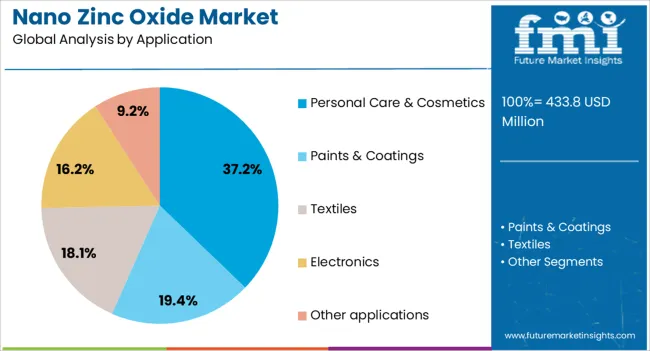
The personal care and cosmetics segment is expected to account for 37.2% of the nano zinc oxide market revenue share in 2025, making it the leading application area. This dominance is being reinforced by the growing demand for effective and safe UV protection in skincare and cosmetic formulations. Nano zinc oxide offers broad-spectrum UV blocking capability while maintaining transparency, which is crucial for modern cosmetic products that prioritize both protection and aesthetics.
Its antimicrobial and anti-inflammatory properties add value in formulations designed for sensitive skin. Increasing awareness of sun-induced skin damage, coupled with lifestyle shifts toward outdoor activities, is driving higher usage in sunscreens, moisturizers, and makeup products with SPF. Regulatory support for mineral UV filters in various regions is further encouraging manufacturers to incorporate nano zinc oxide into their product lines.
Continuous innovations in particle coating and dispersion technologies are enhancing product stability and sensory feel, ensuring consumer acceptance As demand for multifunctional, safe, and environmentally friendly cosmetic ingredients grows, this segment is positioned to sustain its market leadership.
The global nano zinc oxide market is projected to expand due to rising demand across sectors such as cosmetics, healthcare, and electronics. Opportunities are growing in emerging economies, where industrialization and increasing disposable income are driving consumption. Market trends reflect a shift toward multifunctional products, and nano zinc oxide is being adopted for its superior properties in diverse applications. However, challenges related to safety concerns, regulatory compliance, and manufacturing efficiency could affect the market’s full potential.
The demand for nano zinc oxide is increasing significantly due to its growing applications in industries like cosmetics, healthcare, electronics, and textiles. Its use in sunscreens and personal care products, which leverage its UV-blocking properties, is particularly prominent. In electronics, nano zinc oxide is being integrated into flexible displays, enhancing the durability and performance of devices. The automotive sector is also adopting nano zinc oxide for improved materials. These applications are fueling demand as the market continues to expand.
Emerging economies, particularly in Asia-Pacific, present significant growth opportunities for the nano zinc oxide market. The rise in industrial activities and an increasing focus on health and wellness products have created avenues for market expansion. As disposable incomes rise, consumers are leaning toward more efficient and high-performing products, including cosmetics with advanced ingredients like nano zinc oxide. Regional markets are witnessing a surge in infrastructure projects, leading to a demand for functional materials, including coatings that utilize nano zinc oxide, thereby creating new opportunities for growth.
The trend towards multifunctional ingredients is reshaping the adoption of nano zinc oxide. As consumers seek products with more benefits, nano zinc oxide’s ability to offer both UV protection and antimicrobial properties is attracting attention. Furthermore, the growing interest in organic and natural cosmetics is driving product formulations that leverage nano zinc oxide's skin-friendly qualities. In the medical field, advancements in wound healing applications are fueling the material's adoption in clinical settings. These trends are creating long-term demand and expanding market applications.
Despite its potential, the nano zinc oxide market faces challenges that could hinder its growth. Regulatory concerns regarding the safety of nano-scale materials, especially in cosmetics and healthcare products, pose significant hurdles. The potential environmental impact of nano materials, particularly in water systems, has attracted scrutiny from environmental bodies. Manufacturing processes also face challenges in achieving uniform particle sizes and quality control, which affects product consistency. These challenges need to be addressed through enhanced research and development, and strict compliance with regulations.
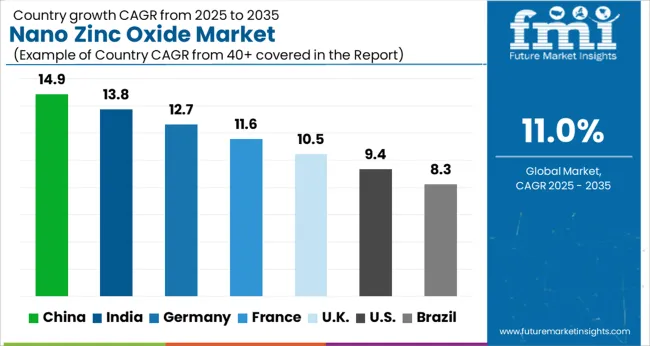
| Country | CAGR |
|---|---|
| China | 14.9% |
| India | 13.8% |
| Germany | 12.7% |
| France | 11.6% |
| UK | 10.5% |
| USA | 9.4% |
| Brazil | 8.3% |
The global nano zinc oxide market is projected to grow at a robust CAGR of 11% from 2025 to 2035. China leads the market with a growth rate of 14.9%, followed by India at 13.8% and Germany at 12.7%. The United Kingdom records a growth rate of 10.5%, while the United States shows a more moderate growth rate of 9.4%. These varying growth rates are driven by increasing demand for high-performance materials in industries such as cosmetics, pharmaceuticals, and electronics. Emerging markets like China and India are witnessing higher growth due to rapid industrialization, increasing consumer demand for personal care products, and advancements in pharmaceuticals. On the other hand, more developed markets like the USA and the UK see steady growth supported by regulatory frameworks, increased adoption of eco-friendly products, and the growing focus on natural ingredients. This report includes insights on 40+ countries, with the top markets highlighted here for reference.
The nano zinc oxide market in China is projected to grow at an impressive CAGR of 14.9%. The country's rapid industrialization, particularly in electronics, pharmaceuticals, and cosmetics, is a key driver behind the robust demand for nano zinc oxide. China's growing consumer base and emphasis on high-quality production in industries like electronics further fuel the market. Moreover, advancements in green technologies and environmental concerns push the demand for eco-friendly and multifunctional products such as nano zinc oxide.
The nano zinc oxide market in India is projected to grow at a CAGR of 13.8%. India’s expanding pharmaceutical, cosmetic, and automotive industries are increasingly utilizing nano zinc oxide for its anti-inflammatory and UV-protective properties. The growing consumer demand for personal care products, coupled with advancements in medical and pharmaceutical applications, is driving this growth. The government's focus on health and wellness sectors also supports the increasing adoption of nano zinc oxide.
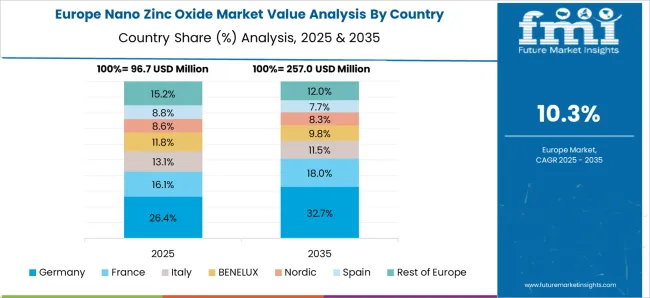
The nano zinc oxide market in Germany is projected to grow at a CAGR of 12.7%. As a leader in the European market, Germany’s industrial sectors, particularly in electronics, automotive, and cosmetics, are increasingly incorporating nano zinc oxide due to its wide range of applications. The country’s strong regulatory framework and focus on innovation further contribute to the market’s steady expansion. Nano zinc oxide’s use in creating eco-friendly and multifunctional products is a major driver in Germany’s market.
The nano zinc oxide market in the United States is projected to grow at a CAGR of 9.4%. The USA remains a key player, with its robust electronics, healthcare, and personal care sectors driving the market demand. The growing awareness around skin protection products and the increasing popularity of natural skincare formulations further contribute to the market's expansion. Moreover, the USA is focusing on advancements in nanotechnology, which is expected to support the growth of nano zinc oxide across multiple industries.

The epoxy active diluent market in the United States is expected to expand at a CAGR of 4.3% between 2025 and 2035, indicating slower but stable growth compared to Asian economies. Industrial applications are concentrated in automotive, construction, and marine coatings, where diluents enable easier application and performance enhancement. The aerospace industry’s requirement for lightweight composites continues to generate consistent demand. Strict USA chemical safety and environmental standards drive the preference for low-viscosity, non-toxic diluents, creating opportunities for specialized producers. Growth is tempered by market maturity and high penetration of established resin systems, yet innovation in electronics encapsulation and 3D printing materials presents emerging opportunities.
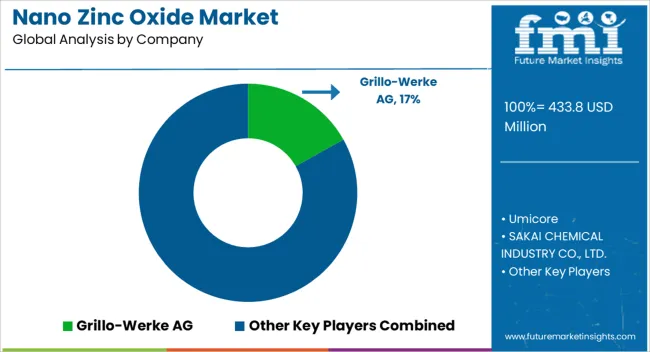
The nano zinc oxide market is highly competitive, with major players advancing product innovation, purity, and application versatility across cosmetics, coatings, electronics, and pharmaceuticals. Grillo-Werke AG, Umicore N.V., and BASF SE lead the market through extensive R&D and advanced nano zinc oxide formulations offering superior UV protection, transparency, and dispersion. These companies leverage strong distribution networks and sustainable production technologies to meet demand from personal care, polymer, and energy storage industries.
Showa Denko K.K., Lanxess Corporation, and SAKAI Chemical Industry Co. Ltd. focus on producing high-purity nano zinc oxide for electronics, automotive coatings, and specialty ceramics. Their strength lies in precision manufacturing and compliance with strict industrial and environmental standards. Pan-Continental Chemical Co. Ltd. and EverZinc emphasize scalable, cost-efficient production systems catering to pharmaceuticals, rubber, and paints. Both companies are expanding in Asia-Pacific to meet rising regional demand.
Nanophase Technologies Corporation and Inframat Advanced Materials LLC specialize in engineered nanoparticles, supplying tailored nano zinc oxide products for defense, electronics, and biomedical applications. Market competition centers on innovation, consistency, and regulatory alignment. Firms investing in sustainable nanomaterial synthesis, surface modification, and multi-functional applications are best positioned for long-term growth.
| Item | Value |
|---|---|
| Quantitative Units | USD 433.8 Million |
| Product Type | Coated nano ZnO and Un-coated Nano ZnO |
| Application | Personal Care & Cosmetics, Paints & Coatings, Textiles, Electronics, and Other applications |
| Regions Covered | North America, Europe, Asia-Pacific, Latin America, Middle East & Africa |
| Country Covered | United States, Canada, Germany, France, United Kingdom, China, Japan, India, Brazil, South Africa |
| Key Companies Profiled | Grillo-Werke AG, Umicore N.V., SAKAI Chemical Industry Co. Ltd., Pan-Continental Chemical Co. Ltd., Inframat Advanced Materials LLC, Showa Denko K.K., Lanxess Corporation, Nanophase Technologies Corporation, EverZinc, and BASF SE. |
| Additional Attributes | Dollar sales by product type (Coated vs. Uncoated), dollar sales by form (powder, suspension, paste), trends in UV protection and cosmetic formulations, use in antimicrobial applications, growth in industrial and automotive sectors, and regional variations in usage are key attributes shaping the landscape of this sector. |
The global nano zinc oxide market is estimated to be valued at USD 433.8 million in 2025.
The market size for the nano zinc oxide market is projected to reach USD 1,231.8 million by 2035.
The nano zinc oxide market is expected to grow at a 11.0% CAGR between 2025 and 2035.
The key product types in nano zinc oxide market are coated nano zno and un-coated nano zno.
In terms of application, personal care & cosmetics segment to command 37.2% share in the nano zinc oxide market in 2025.






Our Research Products

The "Full Research Suite" delivers actionable market intel, deep dives on markets or technologies, so clients act faster, cut risk, and unlock growth.

The Leaderboard benchmarks and ranks top vendors, classifying them as Established Leaders, Leading Challengers, or Disruptors & Challengers.

Locates where complements amplify value and substitutes erode it, forecasting net impact by horizon

We deliver granular, decision-grade intel: market sizing, 5-year forecasts, pricing, adoption, usage, revenue, and operational KPIs—plus competitor tracking, regulation, and value chains—across 60 countries broadly.

Spot the shifts before they hit your P&L. We track inflection points, adoption curves, pricing moves, and ecosystem plays to show where demand is heading, why it is changing, and what to do next across high-growth markets and disruptive tech

Real-time reads of user behavior. We track shifting priorities, perceptions of today’s and next-gen services, and provider experience, then pace how fast tech moves from trial to adoption, blending buyer, consumer, and channel inputs with social signals (#WhySwitch, #UX).

Partner with our analyst team to build a custom report designed around your business priorities. From analysing market trends to assessing competitors or crafting bespoke datasets, we tailor insights to your needs.
Supplier Intelligence
Discovery & Profiling
Capacity & Footprint
Performance & Risk
Compliance & Governance
Commercial Readiness
Who Supplies Whom
Scorecards & Shortlists
Playbooks & Docs
Category Intelligence
Definition & Scope
Demand & Use Cases
Cost Drivers
Market Structure
Supply Chain Map
Trade & Policy
Operating Norms
Deliverables
Buyer Intelligence
Account Basics
Spend & Scope
Procurement Model
Vendor Requirements
Terms & Policies
Entry Strategy
Pain Points & Triggers
Outputs
Pricing Analysis
Benchmarks
Trends
Should-Cost
Indexation
Landed Cost
Commercial Terms
Deliverables
Brand Analysis
Positioning & Value Prop
Share & Presence
Customer Evidence
Go-to-Market
Digital & Reputation
Compliance & Trust
KPIs & Gaps
Outputs
Full Research Suite comprises of:
Market outlook & trends analysis
Interviews & case studies
Strategic recommendations
Vendor profiles & capabilities analysis
5-year forecasts
8 regions and 60+ country-level data splits
Market segment data splits
12 months of continuous data updates
DELIVERED AS:
PDF EXCEL ONLINE
Zinc Oxide Block Market Size and Share Forecast Outlook 2025 to 2035
Zinc Oxide Market Forecast and Outlook 2025 to 2035
Zinc Oxide Sunscreens Market Size and Share Forecast Outlook 2025 to 2035
Zinc Oxide for Sunscreens Market Analysis - Size, Share, and Forecast Outlook 2025 to 2035
Industry Share Analysis for Nano Metal Oxide Providers
Cerium Oxide Nanoparticle Market Growth – Trends & Forecast 2024-2034
High Purity Nano Aluminum Oxide Powder Market Size and Share Forecast Outlook 2025 to 2035
Metal & Metal Oxide Nanoparticles Market Growth – Trends & Forecast 2024-2034
High Voltage Ceramic Zinc Oxide Surge Arrester Market Size and Share Forecast Outlook 2025 to 2035
Nanoscale Zero-Valent Iron Market Size and Share Forecast Outlook 2025 to 2035
Nanoscale Sand Mill Market Size and Share Forecast Outlook 2025 to 2035
Zinc-tin Alloy Sputtering Target Market Size and Share Forecast Outlook 2025 to 2035
Nano Coating Market Size and Share Forecast Outlook 2025 to 2035
Nano Fibers Market Size and Share Forecast Outlook 2025 to 2035
Nanotechnology Photocatalysis Surface Coating Industry Analysis in AMEA Size and Share Forecast Outlook 2025 to 2035
Nanosensors Market Size and Share Forecast Outlook 2025 to 2035
Nano Precipitated Calcium Carbonate Market Size and Share Forecast Outlook 2025 to 2035
Nanocatalysts Market Size and Share Forecast Outlook 2025 to 2035
Nano Suspension Market Analysis - Size, Share, and Forecast Outlook 2025 to 2035
Nanotechnology Packaging Market Size and Share Forecast Outlook 2025 to 2035

Thank you!
You will receive an email from our Business Development Manager. Please be sure to check your SPAM/JUNK folder too.
Chat With
MaRIA